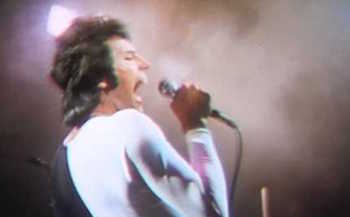Here’s what you do to a song to make it feel like an anthem.
 “The Essential Secrets of Songwriting” eBook Bundles will strengthen your songwriting technique, and take you to a new level of musical excellence. The 10-eBook Deluxe Bundle comes with”From Amateur to Ace: Writing Songs Like a Pro“. Read more..
“The Essential Secrets of Songwriting” eBook Bundles will strengthen your songwriting technique, and take you to a new level of musical excellence. The 10-eBook Deluxe Bundle comes with”From Amateur to Ace: Writing Songs Like a Pro“. Read more..
- speaks to a universal issue;
- speaks to (and/or as) an identifiable group of people ; and
- either begs for change, or acknowledges/celebrates changes that have occurred (mostly societal ones).
So in a rock anthem, you’ll either hear a lot about “we” (“We’re Not Gonna Take It” – Twisted Sister, “We Are the Champions” – Queen). You’ll also hear a lot about “you” in the plural sense (“All You Need Is Love” – The Beatles).
In any case, an anthem needs to get a large group of people to identify with the message, feeling that the song lyric sums up their feelings on a particularly strong issue.
It comes mainly from the lyric, of course, but there are things you can do in the creation of your music that can and will power up the lyric’s message:
- Match the tempo (if you can) to the kind of message you’re conveying. In “We’re Not Gonna Take It”, its driving tempo seems to perfectly match the “we’ll fight the powers that be”. An uplifting song with a message of love or personal strength connects better with a slower tempo (“All You Need Is Love”, “We Are the Champions.”
- Use mainly strong chord progressions. A strong progression is one that clearly points to the key of the song. The basic I-IV-V progression of “We’re Not Gonna Take It” works so well because we recognize the strength of that progression on a subconscious level, and it mirrors exactly what we’re getting from the lyrics.
- Try secondary dominant chords. A secondary dominant (s.d.) can take a while to explain, but it suffices to say that if you take a chord that’s normally minor in a key, change it to major, and then be sure that the next chord’s root is 4 notes higher, you’ve created an s.d. There’s something uplifting and positive about an s.d, and it’s probably why you see them so often in rock anthems. (Example: “All You Need Is Love”, Key: G major. Chorus (the s.d.’s are in bold: G A D|G A D|G B Em…). They are s.d. chords because you would normally get Am and Bm in the key of G major.
- Make sure the lyrics are speaking to (or speaking as) an identifiable group of people. In “We’re Not Gonna Take It”, it’s youth. In “We Are The Champions”, it’s the otherwise disadvantaged. If you’re only speaking on your own behalf, about an issue that’s troubling you, that’s completely fine of course. But it may not put your song in the category of an anthem. So that’s where “we”, “us”, and “you” (in the plural sense) becomes important.
- Give your melody a climactic high point. This is especially true of the chorus melody. A climactic high point seems to give an important point of focus for all the emotions that you’re putting into your lyric. It’s often best if that climactic moment is in the second half of the chorus melody.
Some anthems don’t specifically speak to a group of people, but as listeners we get the feeling that they’re addressing a wider societal issue. A good example might be “Bridge Over Troubled Water“, which is sung from one person’s point of view, but we all feel encouraged and uplifted by its message in much the same way that we do with other anthems.
“Titanium“, by David Guetta, Sia et al, is another example of an anthem-like song that focuses on the singer as an individual, but in such a way that we all strongly identify with the message.
Getting your audience to identify as part of a larger group is an important part of what makes a song an anthem. Keep your message positive and confident, and you’ve already done the most important part of writing a strong anthem.
______________
 Written by Gary Ewer. Follow on Twitter.
Written by Gary Ewer. Follow on Twitter.
“The Essential Secrets of Songwriting” 10-eBook Deluxe Bundle looks at songwriting from every angle, and has been used by thousands of songwriters. How to use chords, write melodies, and craft winning lyrics. Includes a copy of “Writing a Song From a Chord Progression.”











Reblogged this on I Write The Music.